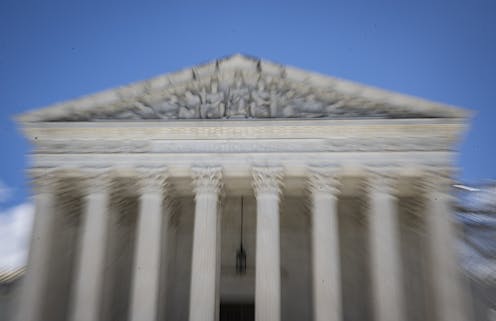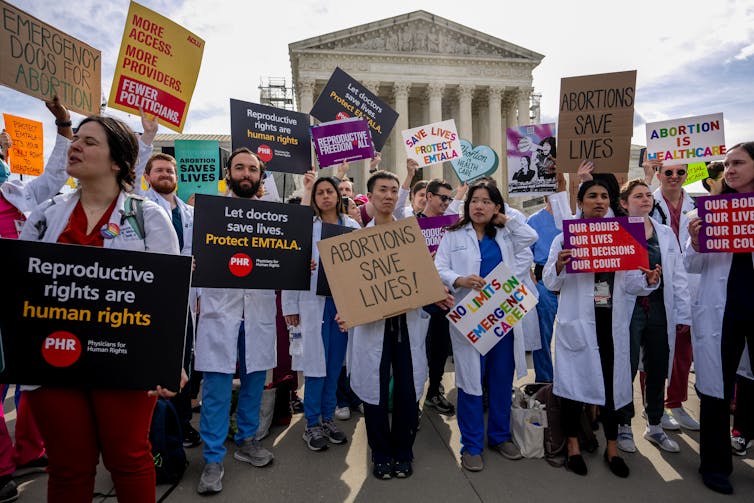Supreme Court’s blow to federal agencies’ power will likely weaken abortion rights – 3 issues to wat
The Supreme Court’s recent ruling means that judges will have more power than scientific experts in determining whether people should be able to get an emergency abortion, for example.

The Supreme Court wrapped up its term at the beginning of July 2024 with a range of rulings that reshape everything from the power of the presidency to how federal agencies carry out their work.
One of the court’s most significant decisions was Loper Bright Enterprises v. Raimondo. This ruling, at its core, determines the balance of power between the judiciary branch’s federal courts and the executive branch’s federal agencies.
When Congress passes laws, legislators know that many will have gaps and ambiguities. It is generally the job of federal agencies – staffed with subject-matter experts – to issue regulations to fill in that detail.
Before the Supreme Court’s July ruling, courts deferred to those agency decisions. Now, in a reversal of 40 years of precedent, courts, not agencies, will have the last word on interpreting federal law.
Loper did not automatically reverse all agency determinations made over the past 40 years. But, going forward, Loper’s shift of power from federal agencies to the federal courts will have profound effects on many different policies and laws – including those that deal with abortion and reproductive rights.
Lawyers and scholars like me who study reproductive rights understand that federal agencies, such as the Department of Health and Human Services and the Food and Drug Administration, generally have the scientific and medical expertise necessary to set guidance for and implement effective, evidence-based reproductive health care policy.
For example, the FDA first approved mifepristone, one of the two drugs that can cause nonsurgical medical abortions, in 2000. The agency’s medical and scientific experts reviewed decades of evidence from clinical trials and highly technical scientific studies and found that the drug was safe and effective.
Here are three abortion and reproductive rights issues in which federal agency decision-making could be tested in the months and years to come.

1. The FDA and mifepristone
This spring, the Supreme Court also issued a ruling related to the FDA’s approval of mifepristone, in a case called FDA v. Alliance for Hippocratic Medicine.
This case’s origins trace back to 2022, when this alliance, a coalition of medical professionals who oppose abortion, sued the FDA. It wanted to remove mifepristone from the U.S. market on the theory that the FDA never should have approved the drug – despite mifepristone’s long record of safety and efficacy. A Texas federal court agreed with the Alliance for Hippocratic Medicine, effectively reversing the FDA’s approval and removing the drug from the market. The FDA then appealed to the Supreme Court.
The Supreme Court held in June 2024 that these medical professionals did not have “standing” – that is, they were not the correct plaintiffs to bring the case because, as medical professionals who don’t provide abortions, they weren’t affected by mifepristone’s availability. The Supreme Court did not actually consider whether mifepristone should be removed from the market.
However, it is almost certain that a similar challenge to the FDA’s authority to regulate mifepristone will soon be back before the Supreme Court. Indeed, the lawyers for the Alliance for Hippocratic Medicine have already signaled that they will continue the medical abortion case, this time with U.S. states as plaintiffs.
And when this case reaches the Supreme Court, it is an open question whether the justices will defer to the FDA’s authority to approve and regulate mifepristone – or whether they will substitute their own judgment for the FDA’s. The court could, for instance, reverse the FDA’s determination that mifepristone should be available by telemedicine, without an in-person appointment, or even reverse the FDA’s approval of the drug.
Given that medical abortion – often with mifepristone – is the most common way someone has an abortion in the U.S., such a decision could dramatically reduce access to this safe abortion method, including for patients who have no other safe options.
2. Emergency abortion care
Similar issues about federal agencies’ power come up when considering emergency abortions – meaning abortions precipitated by a medical emergency that places the pregnant person’s health on the line.
Abortion is considered the standard treatment for some pregnancy emergencies, such as when a pregnant person’s water breaks before the fetus is viable.
This spring, the Supreme Court took up a conflict between a federal law called the Emergency Medical Treatment and Active Labor Act, or EMTALA, and an Idaho state abortion ban.

EMTALA requires that emergency rooms provide care to all patients regardless of their ability to pay. After the Supreme Court overturned Roe v. Wade in June 2022, the Department of Health and Human Services issued guidance stating that EMTALA requires hospitals to perform emergency abortions if a pregnant patient’s life or health is in danger. This is true even if the abortion happens in a place like Idaho that has a near-total abortion ban.
The court considered whether Idaho emergency rooms had to comply with the Department of Health and Human Services’ guidance and provide emergency abortions.
In a plot twist, the court declined to give an answer and instead punted the case back to a lower court. The Idaho case will now make its way to the 9th U.S. Circuit Court of Appeals. In the meantime, Idaho emergency rooms can and must provide emergency abortion care.
However, the 5th U.S. Circuit Court of Appeals came to the opposite decision in a nearly identical case, Texas v. Becerra. That court ruled in January 2024 that, despite the federal mandate, Texas doctors cannot provide emergency abortion care to protect a patient’s health.
So now, the validity of federal guidance on emergency abortions depends on the state in which a pregnant person lives and which judge hears the case – almost guaranteeing that this issue will be back before the Supreme Court.
3. Department of Education and Title IX
Loper’s effect on reproductive rights could also be felt in a more tangential sense, such as in current higher education court cases.
At least 20 states around the country are challenging the Department of Education’s interpretation of Title IX. Title IX is a federal law that prohibits sex discrimination in education.
The Department’s Title IX regulations provide enhanced protections for LGBTQIA+ students and sexual harassment survivors and protect students from discrimination based on “pregnancy or related conditions,” including whether they have had or need to get an abortion.
States such as Louisiana, Mississippi, Montana and Iowa have successfully sued in federal district court to halt implementation of the new regulations.
A pending case in a Texas federal court highlights how abortion access could be implicated in these broader challenges to the agency’s Title IX regulations.
In that case, two University of Texas at Austin professors said that they will, contrary to the Department of Education’s guidance, discriminate against students who get abortions by penalizing students who miss class to terminate a pregnancy and refusing to employ teaching assistants who help others get abortions.
If the Texas federal court rules in favor of the Texas professors, it will join the other courts that have dismissed agency rulemaking and erode protections for college students who have abortions.
A collision course with Loper
In her Loper dissent, Justice Elena Kagan wrote: “In every sphere of current or future federal regulation, expect courts from now on to play a commanding role.”
Loper will fundamentally change how federal agencies do their work, particularly those that deal with highly complex medical or scientific issues.
Kagan’s dissent raises the specter of judges across the country – not doctors or scientists or educators, nor even politicians, who at least must answer to the public – playing a “commanding role” in reproductive rights policy.
Jessica L. Waters does not work for, consult, own shares in or receive funding from any company or organization that would benefit from this article, and has disclosed no relevant affiliations beyond their academic appointment.
Read These Next
As US hunger rises, Trump administration’s ‘efficiency’ goals cause massive food waste
Despite the administration’s claim of streamlining the government to make its operations more efficient,…
A year on, the Israeli-Lebanese ceasefire looks increasingly fragile − could a return to cyclical vi
Since the start of the truce on Nov. 27, 2024, there have been thousands of Israeli violations inside…
Absence of evidence is not evidence of absence – and that affects what scientific journals choose to
Researchers design studies that might disprove what’s called their null hypothesis – the opposite…





